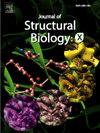细胞膜中高度通用的小病毒编码蛋白:蛋白质固有构象可塑性如何与宿主膜特性偶联以控制细胞过程的结构视角
IF 5.1
Q2 BIOCHEMISTRY & MOLECULAR BIOLOGY
引用次数: 0
摘要
我们研究了几种存在于细胞膜上并起作用的小病毒蛋白。这些蛋白质属于毒孔蛋白家族,因为它们组装成离子传导低聚物。然而,尽管形成类似的低聚结构和类似的功能,这些蛋白质具有不同的氨基酸序列。特别是,所提出的形成通道的跨膜(TM)螺旋的氨基酸组成有很大的不同——一些含有可以促进阳离子运输的残基(例如,His, Trp, Asp, Ser)。尽管如此,其他病毒蛋白的TM螺旋只包含疏水性残基;因此,很难解释其通道的活性,除非发生其他机制(例如,涉及负脂质头基团和/或膜不稳定)。在这项研究中,我们分别从甲型流感病毒、HIV-1病毒、人t细胞白血病病毒、丙型肝炎病毒和小核糖核酸病毒中选择了M2、Vpu、E、p13II、p7和2B蛋白。我们简要概述了目前对这些蛋白质结构的认识,以及对其结构,构象动力学和功能的更全面理解的剩余问题。最后,我们概述了利用多管齐下的结构和计算方法来克服目前对这些蛋白质知识的不足的策略。本文章由计算机程序翻译,如有差异,请以英文原文为准。

Highly versatile small virus-encoded proteins in cellular membranes: A structural perspective on how proteins’ inherent conformational plasticity couples with host membranes’ properties to control cellular processes
We investigated several small viral proteins that reside and function in cellular membranes. These proteins belong to the viroporin family because they assemble into ion-conducting oligomers. However, despite forming similar oligomeric structures with analogous functions, these proteins have diverse amino acid sequences. In particular, the amino acid compositions of the proposed channel-forming transmembrane (TM) helices are vastly different—some contain residues (e.g., His, Trp, Asp, Ser) that could facilitate cation transport. Still, other viroporins’ TM helices encompass exclusively hydrophobic residues; therefore, it is difficult to explain their channels’ activity, unless other mechanisms (e.g., involving a negative lipid headgroups and/or membrane destabilization) take place. For this study, we selected the M2, Vpu, E, p13II, p7, and 2B proteins from the influenza A, HIV-1, human T-cell leukemia, hepatitis C, and picorna viruses, respectively. We provide a brief overview of the current knowledge about these proteins’ structures as well as remaining questions about more comprehensive understanding of their structures, conformational dynamics, and function. Finally, we outline strategies to utilize a multi-prong structural and computational approach to overcome current deficiencies in the knowledge about these proteins.
求助全文
通过发布文献求助,成功后即可免费获取论文全文。
去求助
来源期刊

Journal of Structural Biology: X
Biochemistry, Genetics and Molecular Biology-Structural Biology
CiteScore
6.50
自引率
0.00%
发文量
20
审稿时长
62 days
 求助内容:
求助内容: 应助结果提醒方式:
应助结果提醒方式:


